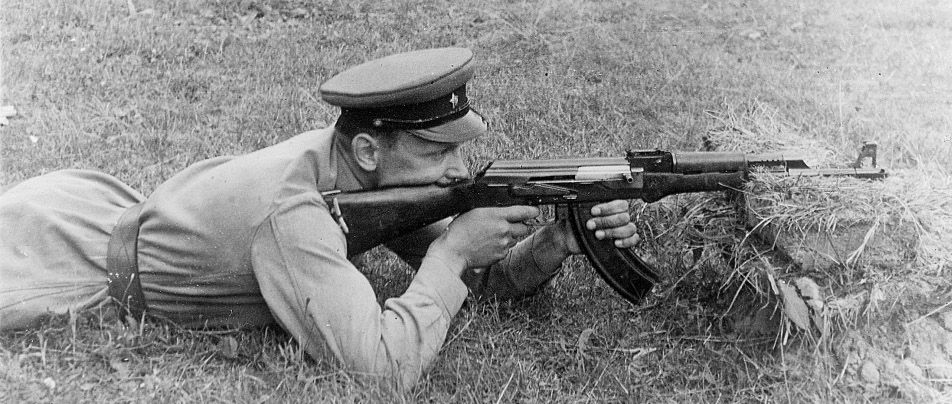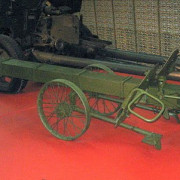Заново рождённый. удивительная история ак-47 № 1
Содержание:
Самый зелёный автомат
В гроверском мире есть одна истина, которая нигде не записана, однако это не делает ее менее реальной. Она гласит, что каждый мега крутой сорт рано или поздно увековечат в автоцветущей версии.
После получения стольких наград АК 47, бридеры скрестили фотопериодичный сорт с Лориком. Растить полученный автоцвет стало еще проще, а его сила и вкусоароматические характеристики остались на высоте. Урожайность тоже не пострадала. Один небольшой куст вполне способен принести до 250 г шишек. Кто-то скажет мало. Однако стоит помнить, что харв начинается на 8-ю неделю от каски, то есть в рекордные сроки.
Design details
AKs are long-stroke gas piston operated rifles. Most AKs are select-fire rifles; some have been converted to only fire semi-automatically. In all cases, the selector doubles as a dust cover; when the rifle is on SAFE, the selector covers the channel the charging handle travels in.
Receivers
The first production AKs were designed to be built with stamped receivers (in line with Schmeisser’s expertise in this method of production), but this proved unworkable with Soviet production controls of the era and the rejection rate was very high. Functional examples of stamped first-production AKs were usually hand-finished via milling.
As a result, production AKs have milled steel receivers. These are identified by two milled out sections, right above the magazine well, one on each side of the receiver. These are known as AK receivers, and were rather expensive to produce.
Most modern AKs use stamped sheet metal receivers: this started with the AKM in 1959. The metal is 1mm thick. These receivers, with a couple of exceptions (Romanian WASR-10 rifles, Saiga rifles), have two dimples, one on each side of the receiver, that serve as magazine guides. These receivers can also be identified by the rivets that hold the front trunnion in the receiver. These receivers are found on AKM rifles, AK-74 rifles, and all rifles of the AK-10X lineage.
Some AKs (Yugoslavian rifles, some Chinese rifles, and all RPKs) have reinforced stamped sheet metal receivers; the metal is 1.6mm thick, instead of 1mm. These can be identified by the rivet that holds the front trunnion in the receiver; it is oversized and reinforced. These tend to be very durable and stable receivers.
Operating system
The piston rod (op rod, actuator rod) is permanently attached to the bolt carrier. The bolt carrier rides on the two rails machined in the receiver with significant clearances between the moving and stationary parts.
The bolt has two lugs that lock into the barrel extension, sealing the chamber when it goes into battery. Upon unlocking, it makes a primary extraction movement on the spent case. This, along with the significant taper of the 7.62x39mm and 5.45x39mm casing, results in very positive and reliable extraction, even with a dirty chamber and dirty or corroded cases. The rotation of the bolt is ensured by the curved cam track, machined in the bolt carrier, and by the appropriate stud on the bolt itself. The action spring and spring guide are located behind the gas piston and are partially hidden in its hollow rear part when the bolt is in battery. The base of the action spring assembly also serves as a receiver cover lock; the serrated end holds the cover down. The charging handle is permanently attached to the bolt carrier (in fact, it forms a single machined steel unit with the carrier), and does reciprocate when the weapon is fired.
Gas block and barrel assembly
The gas block is located on the barrel, and the gas port on modern AKs is drilled at 90 degrees; this was changed from the original 45 degrees due to 5.45mm bullets shearing in the barrel. Generally speaking, there are two thread pitches for the muzzle. AKs and AKMs use a 14/1mm left hand thread, and the barrel itself is threaded. AK-74s use a front sight assembly that slips over the barrel itself, and is threaded. Russian, Bulgarian, and East German AK-74s use a 24mm right-hand thread, while Romanians use a 22mm right-hand thread.
Most AKs, with a couple of exceptions (Yugoslavian rifles and their clones do not have chrome-lined bores), have cold hammer forged barrels with chrome-lined bores to resist corrosion.
Sights
The AK rifles feature rear sights adjustable for range (100 to 800 meters on an AK, 100 to 1000 on everything else), and a front sight, adjustable for elevation and windage. The rear sight is adjusted by pressing in on the slide catch and moving the slide bar along the leaf until the front edge of the bar is aligned with the line below the number that corresponds with the range in meters.
The front sight post is adjusted for elevation by screwing it in and out of the front sight base; a wrench is used to do this. Windage is adjusted by using a tool to move the front sight post mount from side to side. A 1mm adjustment of the front sight changes the point of impact by 26 cm at 100 meters on a 7.62 Soviet AK.
Manual of arms
AKs are short, compact, gas-operated, select-fire weapons. They feed from 30-round box magazines, which have a significant curve if the AK in question is of the 7.62 Soviet variety; 5.45 Russian and 5.56 NATO magazines are straighter, with the 5.45 having a slightly more significant curve due to the taper of its casing.
The magazine is inserted via a «rocking» motion, positioned so that the lug on the front of the magazine engages with its recess in the magazine well, into the magazine well. It should be pulled to the rear until it snaps into place.
In order to operate the charging handle, the selector must be off safe. The charging handle is pulled all the way to the rear and then released to chamber a round. As the bolt carrier goes forward, the lug on the bottom of the bolt will strip a round out of the magazine and feed it into the chamber.
When a round is fired, the gas produced by the propellant in the cartridge goes into the gas tube and impinges upon the operating rod, which then unlocks the bolt and cycles the bolt carrier rearward, which causes it to cock the hammer as it travels. The bolt carrier then strips another round from the magazine and chambers it as it travels forward, and locks the bolt, sealing the round in the chamber.
When the last round is fired, there is no bolt catch mechanism to catch the bolt carrier group and prevent it from closing on an empty chamber. Thus, when the shooter reloads, he will need to rack the charging handle to chamber the next round. If the shooter experiences a malfunction, in most cases racking the charging handle (or reloading, if the magazine is bad OR empty), will solve the problem.
Сорта конопли с генетикой АК 47
Звездная генетика нашла воплощение во многих сортах. На основе оригинального АК 47 бридеры создают, наверное, столько же вариаций, как и в случае с Белой Вдовой или Сканком, то есть очень и очень много. Предлагаем познакомиться с некоторыми из них.
Вкусные, ароматные, смолистые и убойные.
Та самая генетика Ak 47

Сорт каннабиса Ak 47 fem (Семяныч) легко приживается в помещении и на улице. Елки 90-150 см в высоту отцветают к концу октября (примерно 8-9 недель в помещении) и выдают с 1 м2 350-500 г шишек. Если хочется собрать урожай раньше недельки на две, то можно использовать гидропонную установку. К растихам можно применять практически все техники повышения урожайности. Эти девочки стойкие и безотказные, как автомат АК все выдержат. Воздействие у сорта, как и полагается, комбинированное. Сначала сативный хай бьет в мозг сильно, но аккуратно. Вызывая волну отличного настроения, счастья и радостного созидания. Далее, приходит умиротворяющий стоун.
Джек с автоматом

Сорт марихуаны Jack 47 fem (Sweet Seeds) собрал в себе сразу две звездные генетические линии – от АК 47 и от Джека Херера. Это многократный чемпион канна кубков с 75% Сативы и ТГК 24%! В ауте вырастает высоким, нужно быть готовым к этому. Зато легко компенсирует это урожаем. От 500 г шишек с 1 м2 за 66 дней цветения. Растихи не боятся грибков и в целом неприхотливы и живучи. Вкус и аромат готового продукта сладкие цитрусово-фруктовые с хейзовой и землистой ноткой. Интересная фишка – у сорта очень сильный и долгий эффект, мощность хая будет зависеть от времени сбора урожая. Так что гроверы могут с одной посадки получить весь спектр удовольствия.
Выстрел со звездочкой

Сорт конопли Star 47 fem (World of Seeds) тоже является плодом любви двух супер звезд. Легендарный титулованный Сенси Стар и не менее крутой АК 47 создали своим генетическим коктейлем Индика доминантные растишки с ТГК 20% и отличной урожайностью. Им не страшны плесень, грибки и другие беды. Период цветения длится 55-65 дней и приносят примерно 500 г урожая с 1 м2. На цвете очень сильно пахнет сладким сиропом, понадобятся угольные фильтры. Воздействие у сорта очень похоже на родительское – мощное и позитивное.
Не из железа: история
Пожалуй, у этого сорта реально нет недостатков. Наверное, таким его задумывали создатели. Впервые он появился в 1992 году. Для этого скрестили мексиканскую, колумбийскую, афганскую и тайскую генетику. Получился 50/50 гибрид, причем настолько удачный, что его гармоничный хай/стоун эффект до сих пор считается эталонным. Вкус и аромат тоже оказались выше всяких похвал. В насыщенном аромате есть сканковая нотка, в нем чувствуются фрукты и ягоды. Не стоит забывать и о большом количестве вкусного дыма.
Что касается культивации, то она очень легка. Структура кустов компактная индичная. Елочки не превышают в высоту 1,5 м. То есть девочек легко растить в небольшом гроубоксе или запросто замаскировать посадку при культивации на улице. Они не боятся гроверских бед вроде колебаний температур, грибков и плесени.
Отцветает сорт конопли АК 47 за 9 недель максимум и просто поражает своей смолистостью. Шишки растихи производят в большом количестве, они получаются компактными, плотными, полными смолы. При сборе урожая стоит быть внимательным и запастись несколькими парами ножниц, ну или периодически их чистить, поскольку смола покрывает ароматным липким слоем даже листья.
Уровень ТГК тоже крут. В среднем диапазон 19-21%.

Такой вкусный, урожайный и неубиваемый сорт не мог остаться без внимания. Его по достоинству оценили не только гроверы всего мира, но и компетентное жюри. За 27 лет АК 47 получил почти 3 десятка наград, причем на самых крутых канна кубках планеты. Вот только малая часть:
- 1994 год – High Times Cannabis Cup в категории «Hydro» 2-е место.
- 1996 год – High Times Cannabis Cup в категории «Hydro» 3-е место.
- 1999 год – Cannabis Cup в категории «Лучшая Сатива» 1-е место.
- 2003 год – Cannabis Cup в категории «Лучшая Индика» 2-е место.
- 2003 год – по версии журнала High Times АК 47 стал сортом года.
- 2005 год – «Лучший гашиш».
Trivia
- The AK-47 is featured on the flag and emblem of Mozambique and the coat of arms of Zimbabwe.
- In Mexico, the AK-47 is known as Cuerno de Chivo (meaning Goat Horn) because of its curved magazine. It is one of the weapons of choice of Mexican drug cartels.
- A theory circulates about Mikhail Kalashnikov having stolen design innovations from Hugo Schmeisser due to Schmeisser’s work for the Soviet Union starting in November 1946, and also that the AK was based off of the StG 44. However, by the time Schmeisser was brough to Izhevsk Mechanical Plant, Kalashnikov already had a working AK-47 (though not called that at the time) and it was being tested over 1000km from Schmeisser.
- Kalashnikov, when asked about his inspirations for the AK, claimed he had never even seen a rifle in the Sturmgewehr series before, and actually said much of his inspiration came from the M1 Carbine. Mechanical similarities of the three weapons end at all of them using the long stroke piston recoil mechanism however.
- Schmeisser did comparatively little while working for the Soviets and did not actually achieve any of the projects that he drafted due to a lack of technical education, despite his extensive experience as a gunsmith. Official documents actually describe Schmeisser as being useless, though this could be deliberate, because he felt he wasn’t being paid well enough and he simply despised working for the Soviets.
History
History Of AK-47
Sergeant Mikhail Kalashnikov, being in the hospital after being wounded, began to develop various small arms during World War II. In 1944 he was assigned to the Izhevsk Machinebuilding Plant (IZHMASH), where he developed a semi-automatic, gas-operated carbine. Starting with this design, outwardly resembling the German Sturmgewehr 44 though not mechanically based on it, he developed an assault rifle that he submitted for official Soviet Army trials in 1946.
During 1946 and early 1947, he redesigned his initial rifle and submitted it to the second trials, held in 1947. The new prototype was deemed superior to the other competitors and was consequently adopted in 1949 as the «7,62mm Avtomat Kalashnikova, obraztsa 1947 goda» (7.62mm Kalashnikov automatic rifle, model of 1947). After extensive field trials it was slightly modified in 1951, but retained the same name. This redesign was performed with the assistance of Hugo Schmeisser, with his role specifically to make Kalashnikov’s weapon more suited to modern mass production techniques. Along with the basic version, a folding stock version had been developed for paratroopers and vehicle crews and was named the AKS.

AKM with border guard presentation green handguards.
By 1959, the AK was modified again, this time more extensively, and was consequently adopted (after trials) as the AKM (Avtomat Kalashnikova Modernizirovannyj — Kalashnikov Automatic Modernized). The key changes were the switch from milling back to stamping as Soviet production techniques became precise enough to do this reliably, and improved trigger/hammer unit that introduced a hammer release delay device (often incorrectly referred to as a rate reducer). Other changes were effected, including a slightly raised buttstock, the pistol grip, and the addition of the removable muzzle flip compensator. This spoon-like compensator is screwed onto the muzzle and uses the muzzle blast to reduce muzzle climb during bursts of automatic fire.
Автоцветущие свойства растения
К классическому сорту АК-47 были добавлены автоцветущие гены Lowryder, из-за чего получился один вид с лучшими качествами двух сортов. Данное скрещивание означает, что теперь марихуану можно выращивать на любом грунте и в любом месте. Цветение будет происходить автоматически, в зависимости от возраста, а не от светового цикла.
Марихуана Automatic АК-47 около 2-х недель будет находиться в вегетативной фазе, затем наступит практически насильственный период цветения. За 50-60 дней, растение даст множество плотных шишек покрытых кристаллами смолы, ветвей и листьев. Автоцветущий сорт АК-47 способен за период цветения выдать от 40 до 70 гр. урожая, с одного растения. Уровень аромата будет достаточно насыщенным, он может быть сладким или пикантным, но в независимости от запаха, эффект будет одинаково сильным.
«Солдат сделал оружие для солдата»
Михаил Тимофеевич рассказывал, что во время работы над АК-47 он и его коллеги стремились избавиться от стереотипов, накопившихся в оружейном деле. Он много общался с простыми солдатами – будущим пользователями его оружия. Сам, будучи рядовым, Калашников хорошо понимал, какими характеристиками должен обладать идеальный автомат: кроме высоких стрелковых качеств, его оружие должно быть удобным и простым. Но, как говорил сам конструктор, «сделать простое иногда во много раз сложнее, чем сложное».

Стрелок с автоматом АК во время полигонных испытаний. 1948 г.
Доработанный автомат АК проявил себя лучше других на испытаниях и был рекомендован к серийному производству. В 1948 году на Ижевском мотозаводе была выпущена первая партия в 1500 стволов. В следующем году «7,62-мм автомат Калашникова образца 1947 года» принят на вооружение, а Михаил Калашников получает Сталинскую премию I степени. Так молодой тридцатилетний сержант обошел маститых ученых в соревновании за основной автомат советской армии. В 1949 году Калашников назначен конструктором Ижмаша, где и продолжил развивать свое изобретение.
Если по кучности стрельбы автомат Калашникова уступал соперникам по конкурсу, то в живучести ему было не отказать. Он продолжал стрелять после замачивания в болотной жиже, падения с высоты на цементный пол, «купания» в песке и воде, заморозки в холодильных камерах. Гениальные конструкторские решения Калашникова обеспечили автомату долгую жизнь, сделав его самым популярным стрелковым оружием в мире. Схема АК-47 отличается высокой оптимизацией и используется конструкторами до сих пор.







